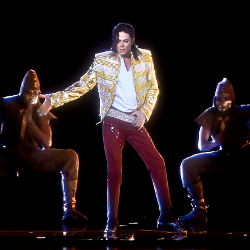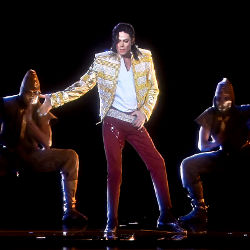
When actor Philip Seymour Hoffman died unexpectedly in February, he still had at least a week of filming left on Mockingjay, the third and fourth installments of the wildly successful Hunger Games movie series. Luckily Hoffman, like other deceased entertainers before him, including rapper Tupac Shakur and singers Michael Jackson, Frank Sinatra, and Elvis Presley, has the potential to live on and charm new audiences through the use of so-called 3D holographic projection systems.
Holography is a technique for recording the wavefront of a 3D scene on a 2D image, according to Ting-Chung Poon, a professor in the Bradley Department of Electrical and Computer Engineering at Virginia Technical Institute. “Dating back a few decades, the process can only be conducted through optical means by mixing the object wave with a reference beam, and recording the resulting fringe pattern on a photographic film,” Poon and colleague P.W.M. Tsang wrote in the 2013 paper Review on Theory and Applications of Wavefront Recording Plane Framework in Generation and Processing of Digital Holograms. “With the rapid advancement of computing technologies in recent years, the optical hologram formation mechanism can be simulated with numerical means.”
The Role of Computers
This approach, commonly referred to as computer-generated holography (CGH), computes the diffraction pattern emitted from a 3D object, and adds a reference wave to produce a digital hologram that can be displayed on electronic devices, says Poon, also a fellow of The Optical Society. “Computer-generated holography deals with the methods of digitally generating holograms. The hologram can be subsequently printed on a film or loaded onto a spatial light modulator (SLM) for holographic reconstruction,” Poon explains.
The phrase “digitally generating holograms” refers to the computer calculations of a hologram for a 3D object, he says. Digital holography (DH) has been made possible through ongoing advances in computing and in optical scanning, along with the growing availability of high-capacity digital storage and wide-band communication technologies.
Merging 19th-Century and Present-Day Technologies
Holography has been a boon for the entertainment and arts industries in particular, with technology that may be used to bring dead performers “back to life.” Musion 3D, for example, a London-based company that develops, markets, produces, and broadcasts 3D holographic illusions, has utilized its Eyeliner technology to resurrect a number of deceased entertainers, including comedian Les Dawson for an ITV appearance in June 2013—an event planned prior to his death in June 1993.
Musion Eyeliner was created in 1995 when company founder Uwe Maass, a laser show engineer, was commissioned to produce a large Pepper’s Ghost display for crystal manufacturer Swarovski. Pepper’s Ghost refers to a 19th-century light projection system that produces lifelike stage effects using plate glass or transparent films and special lighting.
“The [Swarovski] display required an alternative to the use of glass sheets, which hitherto had been the material used to create the illusion, such as in Disney’s Haunted House attraction in California,” says Ian O’Connell, director of Musion 3D. “After researching various polymer compounds, Maass found wide film from Hoechst (now Mitsubishi), which provided the scale required for the image. The large scale achievable, coupled with the advances in HD video projection during this period, provided a renaissance for the Pepper’s Ghost platform.”
There are three key components to an Eyeliner system: a specially developed foil to reflect images from high-definition video projectors; the stage, and the content. The stage is configured in a manner similar to a live music set with audio and lighting, says O’Connell. The foil is configured at a 45-degree angle across the entire stage, “tensioned [taut] within truss framing so as to be invisible to the watching audience.” The content is typically 3D computer-generated imagery (CGI), combined with 35mm film or high-definition video (1080p or 1080i) to complete the effect. “Computers are used in the creation of content, the automation of stage operations such as synchronizing lighting control with video, and finally, in playing back the video content,” he says.
Eyeliner is used primarily for product visualization events such as trade shows, fashion shows, and musical concerts, according to O’Connell. “However, new uses are being created by different industries,” he adds. In February, for example, Interblock S.A., which supplies gaming products to casinos, unveiled its Holographic Gaming Lounge using its own proprietary computer real-time number generator in combination with Musion technology, at the International Casino Exposition/ICE 2014.
“At times, we are streaming tens of millions of pixels of uncompressed video content for GPU. This not only has huge visual processing requirements, but also massive data implications.”
AV Concepts, a provider of holographic and immersive technology, creates holographic illusions using specialized holographic foil, lighting effects, and a proprietary Liquid Scenic projection mapping media server. “The server takes completely uncompressed imagery and uses multiple high-brightness projectors that integrate seamlessly to create very powerful, life-like performances,” explains creative design engineer Alok Wadhwanir. Highly tensioned foil is used to reflect the images.
The Tempe, AZ-based company has done a number of projects using holographic illusion technology in a variety of industries, Wadhwani says, including working with a major hotel chain to bring its CEO to the stage virtually, with a shoe retailer to launch a new sneaker and show the audience the shoe’s internal technology holographically, and with entertainer Dolly Parton to bring the holographic ghosts of Christmas to her Dollywood theme park’s rendition of A Christmas Carol.
Michael Jude, consumer communications services program manager at research firm Frost & Sullivan, cautions that what Musion and others are doing is not pure holographic projection. There are no actual holographic projection systems commercially available, he maintains, adding that these companies are simply creating special effects à la Pepper’s Ghost. “It is a well-known optical illusion coupled with CGI … it takes a laser to generate a real hologram.”
Currently, the only way to do holographics is by looking through a holographic plate/image, which is an interference pattern, Jude says. “If you’re looking to bring Elvis back, you have to generate him somewhere else before projecting [the image] … and that is heavily computer-dependent, and it is not real-time.”
Generating a hologram requires bouncing a laser off whatever it is you want to capture. “You illuminate that [object] with a laser beam and that light bounces off the [object] and strikes a photographic plate,” Jude explains. “Then you shine the same laser beam at the thing at the same time you’re illuminating the photographic plate, to create the interference.” Once the flat interference pattern has been created on the plate, the user can shine the laser through it to generate a hologram.
“It looks very realistic, but transmitting that interference pattern in such a way that it can present a hologram is really, really hard to do,” Jude says. “It has only been done in labs.” Also, true holograms do not appear in full color, Jude says, because they are generated by an ultra-pure laser beam of a specific hue, so they are typically green or red.
So what is being called a holographic projection system commercially is really just “good marketing, and it sounds cool,” Jude says.
Like Musion, Wadhwani acknowledges AV Concepts’ high-definition holographic projection system is based on the Pepper’s Ghost illusion. “We’ve updated it with 21st-century technology to create a three-dimensional, life-size illusion that moves and interacts within a live stage setting,” he adds. “Creating holographic illusions involves specialized, highly tensioned foil, lighting effects and our … Liquid Scenic projection mapping media server to create dynamic visual experiences.”
Software and hardware play a crucial role in producing, designing, creating, and executing the illusions, he says. Visual processing power is supplemented by powerful CPUs and the growing popularity of parallel programming standards such as OpenCL, he says, which give AV Concepts the ability to create and render extremely large, immersive, and “incredibly captivating visual media that was never before possible.” However, Wadhwani adds, there can be complications when trying to create this type of processor-intensive media and ensuring it is reliable, plays in real-time, is synchronized, and is of high quality.
“At times, we are streaming tens of millions of pixels of uncompressed video content per GPU. This not only has huge visual processing requirements, but also massive data implications, leading us to utilize high-volume RAID arrays of solid-state disks,” Wadhwani says. “Networking these systems together creates a powerful server architecture that can be reliably integrated into extremely challenging environments.”
Holography as Art
Ikuo Nakamura, founder of Hololab Studio in New York City, learned about holography during his study of physics at Tokyo University of Science. Nakamura uses a ruby pulse laser to shoot portraits or live objects, and has created holography installations (http://www.hololab.com/holographyart.php) for which he has received numerous awards.
Nakamura works with both digital and 3D film, and says computers play an integral role in holography, since they preserve memories. “For me, [the] computer is [an] extension tool,” he says, which is used as an “interactive device.”
He also says “I want to make it clear, projection on transparent screen[s] is not holography. Holography has true 3D volume.”
Looking Ahead
In terms of creating computer-generated holographic images, it now is possible to generate what Jude calls “a synthetic interference pattern,” but its resolution is very low. “Ultimately, it will be possible to generate fairly complex projections, but the amount of computing [capacity required] is fairly high,” he says.
As the technology progresses, Wadhwani says, the possibilities are infinite. He says AV Concepts recently developed new scalable holographic displays able to quickly, easily, and cost-effectively create holographic illusions on a much smaller scale—something that historically has required expensive custom hardware, software, and engineering, he says.
Future plans for Eyeliner are “to make the images even more realistic, through a combination of 4K video and much brighter image projection using latest-generation LED technology.”
Meanwhile, O’Connell says Musion is working on resurrecting the next dead entertainer with Eyeliner. “All I can say is that the entertainer is male, is still a huge star today and will likely play his first concert in the USA around May or June this year.”
Further Reading
Tsang, P. W. M., Liu, J. P., Cheung, K. W. K., Poon, T. C.
Modern method for fast generation of digital holograms. 3D Research Center and Springer, 2010.
Tsang, Peter, Cheung, W.K., Poon, T.C., Zhou, Z
Holographic video at 40 frames per second for 4-million object points. Department of Electronic Engineering, City University of Hong Kong, Hong Kong; Bradley Department of Electrical and Computer Engineering, Virginia Tech, Blacksburg, VA,; and Shanghai Institute of Optics and Fine Mechanics, Chinese Academy of Science, Shanghai, Optical Society of America, 2011.
Tsang, P.W.M., and Poon, T.C.
Review on theory and applications of wavefront recording plane framework in generation and processing of digital holograms. Department of Electronic Engineering, City University of Hong Kong, Hong Kong; Bradley Department of Electrical and Computer Engineering, Virginia Tech, Blacksburg, VA. Chinese Optics Letters, 2013.
Minas K. Balvan
Object image correction using an X-ray dynamical diffraction Fraunhofer hologram. Journal of Synchotron Radiation, Vol. 21, Part 2. Epub March, 2014.
Bergstrom, P., Khodadad, D., Hallstig, E., Sjodahl, M.
Dual-wavelength digital holography: Single-shot shape evaluation using speckle displacements and regularization. U.S. National Library of Medicine, National Institutes of Health. Applied Optics. January, 2014.
Smalley, D.E., Smithwick, Q.Y.J., Bove, V.M., Barabas, J., Jolly, S.
Anisotropic leaky-mode modulator for holographic video displays. Nature, 498, 313-317. June, 2013.





Join the Discussion (0)
Become a Member or Sign In to Post a Comment